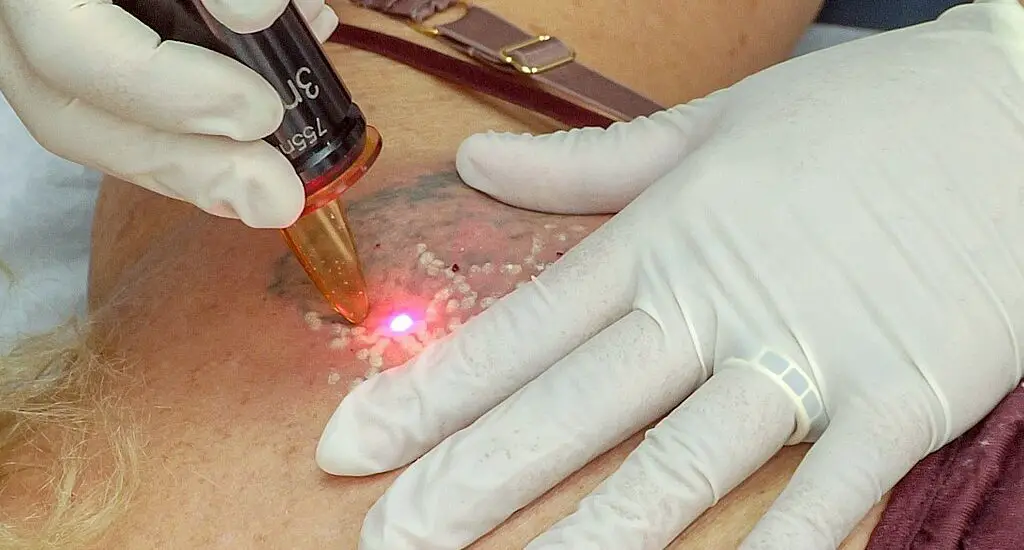How long does skin take to heal after laser tattoo removal? This comprehensive guide details every stage of the healing process.

Table of Contents
How Long Does Skin Take to Heal After Laser Tattoo Removal: Healing Timeline Breakdown
Understanding the healing stages after laser tattoo removal is crucial for proper care and expectation management:
Immediate Reaction (0-7 days)
Right after the treatment, the skin reacts to the laser’s impact. Common symptoms include redness, swelling, and a burning sensation, similar to sunburn. This immediate response is the body’s natural reaction to the laser’s thermal effect on the skin and the disruption of ink particles.
Applying a cool compress and taking over-the-counter pain medication can help alleviate discomfort. It’s essential to avoid any harsh skin treatments and excessive heat on the area during this time.
Initial Healing Phase (1-2 weeks)
This crucial phase involves the skin starting to repair the micro-damage caused by the laser. You may observe blistering, which is a normal response to the thermal effect of the laser on both the ink and surrounding tissue.
Scabbing may also occur as the skin forms a protective barrier over the treated area. It’s vital not to pick at scabs or pop blisters as this can lead to scarring and infection. Keep the area covered with a sterile dressing as instructed by your specialist and continue applying any prescribed ointment to support healing.
Intermediate Phase (2-8 weeks)
During this phase, while external signs like scabbing and blistering have subsided, the skin is still healing beneath the surface. The area may appear lighter or darker than the surrounding skin, which is part of the normal healing process.
It’s important to continue protecting the skin from sun exposure, as the newly healing skin is more susceptible to UV damage. Moisturizing the area can aid in skin repair and comfort.
Long-term Healing (up to several months)
The final stage is where the skin fully recovers and re-establishes its normal texture and appearance. This phase can last several months and is influenced by the body’s natural skin regeneration cycle and the extent of the laser treatment.
It’s crucial during this time to maintain a healthy lifestyle, as factors like nutrition, hydration, and avoiding smoking can significantly impact the speed and quality of healing. Regular follow-up appointments with your specialist are recommended to monitor progress and address any concerns.
Check out this EltaMD Post-Procedure Healing Ointment Laser Balm available at Walmart.
Factors Affecting Healing
The healing time and process after laser tattoo removal can be influenced by various factors:
Size and Location of Tattoo
Larger tattoos require more extensive treatment, which can lead to a longer healing time. Tattoos located in areas with thinner skin or near joints, like ankles or wrists, may also take longer to heal due to increased sensitivity and movement in these areas.
Color of Ink
Different ink colors respond differently to the laser. Darker colors like black and blue absorb laser energy more effectively and thus fade quicker, potentially leading to a shorter healing process. Lighter colors like yellow, green, and red may require more sessions for removal and longer healing periods in between sessions.
Skin Type
Your skin type, including its tone, texture, and sensitivity, can affect the healing process. Darker skin tones may require more cautious treatment to prevent pigmentation changes, while sensitive skin might react more intensely to the laser treatment, possibly prolonging the healing process.
Overall Health and Lifestyle
General health factors such as your immune system’s strength, nutritional habits, hydration levels, and habits like smoking or alcohol consumption significantly impact the healing process. A strong immune system and healthy lifestyle support faster and more effective healing, while smoking and poor nutrition can slow down the process and potentially lead to complications.
Check out these other articles…
Can You Get a Tattoo After Laser Removal? Detailed Answer
Dry Skin After Laser Tattoo Removal: Essential Care Tips
Skin Discoloration After Laser Tattoo Removal: Easy Guide
How Does Skin Look After Laser Tattoo Removal: Easy Guide
Dark Skin After Laser Tattoo Removal: Easy Care Guide
When to Seek Medical Advice
If you notice signs of infection (increased pain, excessive redness, pus, or fever), or if the healing process seems unusually prolonged, seek medical advice immediately. An experienced healthcare provider can assess the situation and provide necessary treatment or advice.

